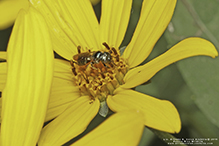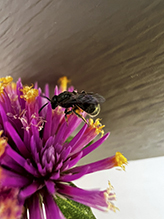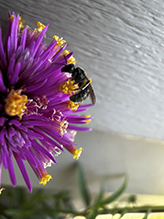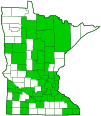small carpenter bees
(Ceratina spp.)
Overview • Description • Distribution • Taxonomy
Description |
||
Ceratina are ¼″ to 5⁄16″ (6 to 8 mm) long, relatively robust, dull, and black, metallic blue, or metallic bluish-green. They are inconspicuously hairy, but the hairs cannot be seen without magnification. The plate on the face (clypeus) almost always has a conspicuous, oblong, white, ivory, or yellowish mark. The mark on the male is larger and in the shape of an inverted T. The antennae are black above, brownish below. The thorax slopes downward gradually toward the rear. On the side of the thorax, the lobe on the rear margin of the pronotum (pronotal lobe, called by some the tubercle) is white, ivory, or yellowish. The abdomen is straight and more or less parallel on the sides then abruptly tapered at the rear. It has broad rounded ridges, somewhat like a water bottle. There are no pale markings or pale hair bands. On the forewing, the basal vein is distinctly arched. The second submarginal cell is about as high as the base is wide. On the hindwing the rear lobe at the base (jugal lobe) is short. The legs have sparse pollen hairs. Spurs on the legs are pale yellow. |
||
Distribution |
||||
|
Sources |
|||
| 8/20/2022 | ||||
Taxonomy |
|||
Order |
Hymenoptera (Ants, Bees, Wasps, and Sawflies) | ||
Suborder |
Apocrita (Narrow-waisted Wasps, Ants, and Bees) | ||
Infraorder |
Aculeata (Ants, Bees, and Stinging Wasps) | ||
Superfamily |
Apoidea (Bees and Apoid Wasps) | ||
| Epifamily | Anthophila (bees) | ||
Family |
Apidae (honey bees, bumble bees, and allies) | ||
Subfamily |
Xylocopinae (carpenter bees) | ||
Tribe |
Ceratinini (small carpenter bees) | ||
Subordinate Taxa |
|||
Subgenus Calloceratina Subgenus Catoceratina Subgenus Ceratina Subgenus Ceratinidia Subgenus Ceratinula Subgenus Copoceratina Subgenus Crewella Subgenus Dalyatina Subgenus Euceratina Subgenus Hirashima Subgenus Lioceratina Subgenus Malgatina Subgenus Megaceratina Subgenus Megaceratina Subgenus Neoclavicera Subgenus Pithitis Subgenus Protopithitis Subgenus Rhysoceratina Subgenus Simioceratina Subgenus Xanthoceratina |
|||
Synonyms |
|||
|
|||
Common Names |
|||
small carpenter bees |
|||
Glossary
Clypeus
On insects, a hardened plate on the face above the upper lip (labrum).
Jugal lobe
In Hymenoptera: The rear lobe at the base of the hindwing.
Pith
The spongy cells in the center of the stem.
Visitor Photos |
|||||
Share your photo of this insect. |
|||||
| This button not working for you? Simply email us at info@MinnesotaSeasons.com. Attach one or more photos and, if you like, a caption. |
|||||
Alfredo Colon |
|||||
 |
|||||
LMG |
|||||
I believe this is a Small Carpenter Bee. Too small to be a sweat bee (@ 1/4 inch). Plus it stung my cat that thought he was investigating a tiny jumping spider! Carpenters are more likely to sting than sweat bees. |
 |
||||
 |
|||||
MinnesotaSeasons.com Photos |
|||||
|
|||||

Visitor Videos |
|||
Share your video of this insect. |
|||
| This button not working for you? Simply email us at info@MinnesotaSeasons.com. Attach a video, a YouTube link, or a cloud storage link. |
|||
Other Videos |
|||
| Ceratina - Small carpenter bee - Insects Insects and Birds |
|||
About
Sep 6, 2021 Ceratina - Small carpenter bee - Insects The cosmopolitan bee genus Ceratina, often referred to as the small carpenter bees, is the only genus of the tribe Ceratininae, and is closely related to the more familiar carpenter bees. They build nests in dead wood, stems, or pith, and while many are solitary, a number are sub-social, with mothers taking care of their larvae, and in some cases where multiple females are found in the same nest. Daughters or sisters can become weakly social colonies (where one bee forages and the other stays in the nest and lays eggs). Video: Mira Road, Thane, Maharashtra, |
|||
| Cavity nesting Ceratina ProfMatteson |
|||
About
Feb 21, 2009 You are viewing a small female bee entering a hollow hydrangea shrub stem where she has built a nest. Hydrangea are common shrubs used in garden landscaping but few gardeners know that bees use the stems for nest sites. The bee is a small carpenter bee in the genus Ceratina. In the stem there are likely several developing larva feeding on regurgitated nectar and/or pollen from the mother. The video was taken on City Island in the Bronx, New York. |
|||
| Ceratina Bee or Small Carpenter Bee Walter Peter Carreon |
|||
About
Apr 8, 2014 This video was uploaded from an Android phone. |
|||

Visitor Sightings |
|||||
Report a sighting of this insect. |
|||||
| This button not working for you? Simply email us at info@MinnesotaSeasons.com. Be sure to include a location. |
|||||
| LMG 8/10/2022 |
Location: New Prague, MN I believe this is a Small Carpenter Bee. Too small to be a sweat bee (@ 1/4 inch). Plus it stung my cat that thought he was investigating a tiny jumping spider! Carpenters are more likely to sting than sweat bees. |
||||
| Alfredo Colon 8/8/2019 |
Location: Woodbury, Minnesota |
||||
MinnesotaSeasons.com Sightings |
|||||
|
|||||

Created: 8/20/2022
Last Updated:




